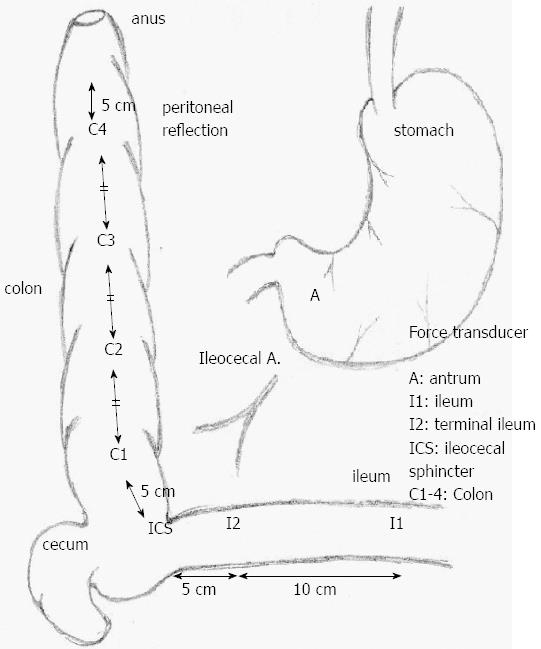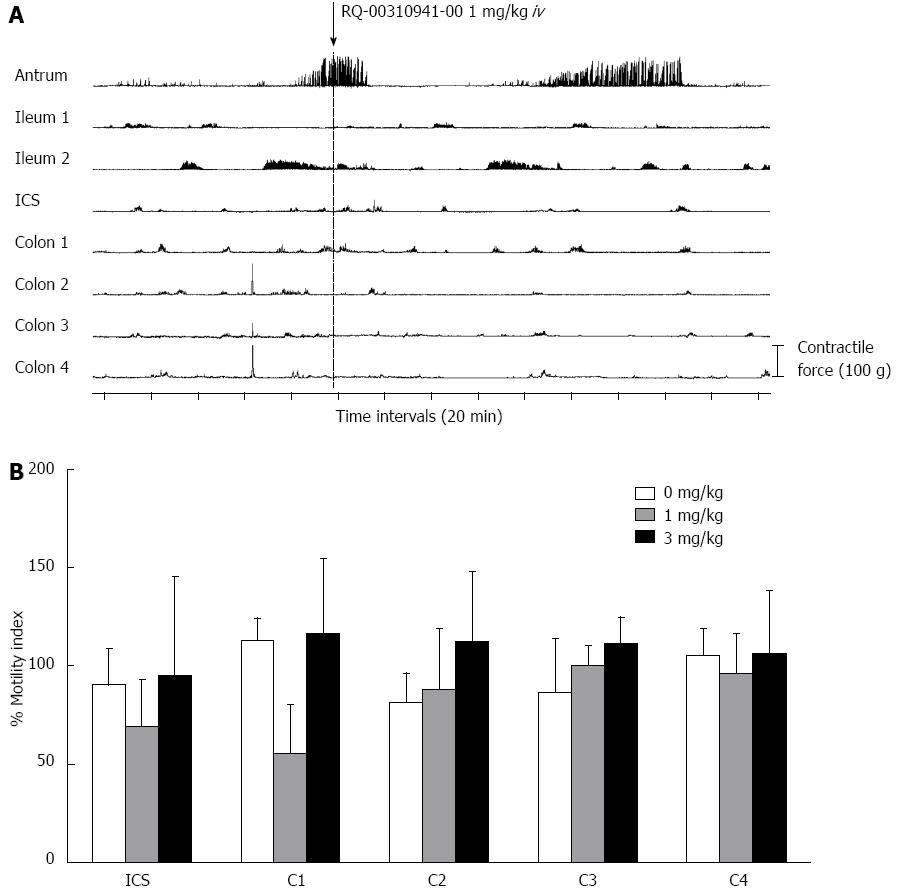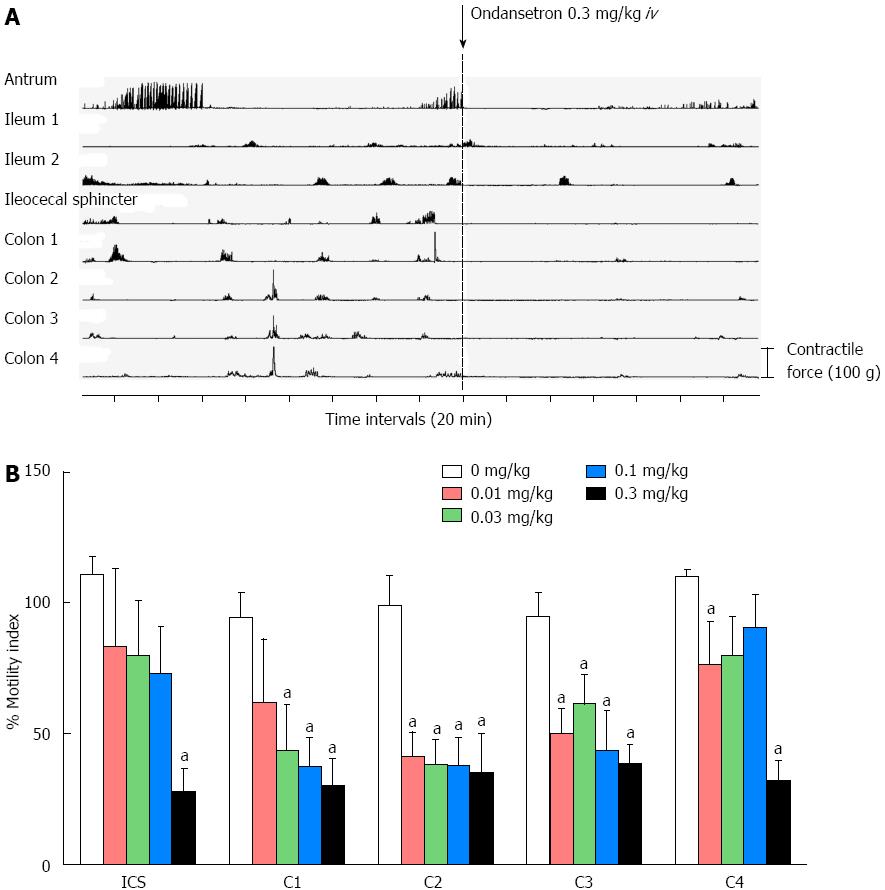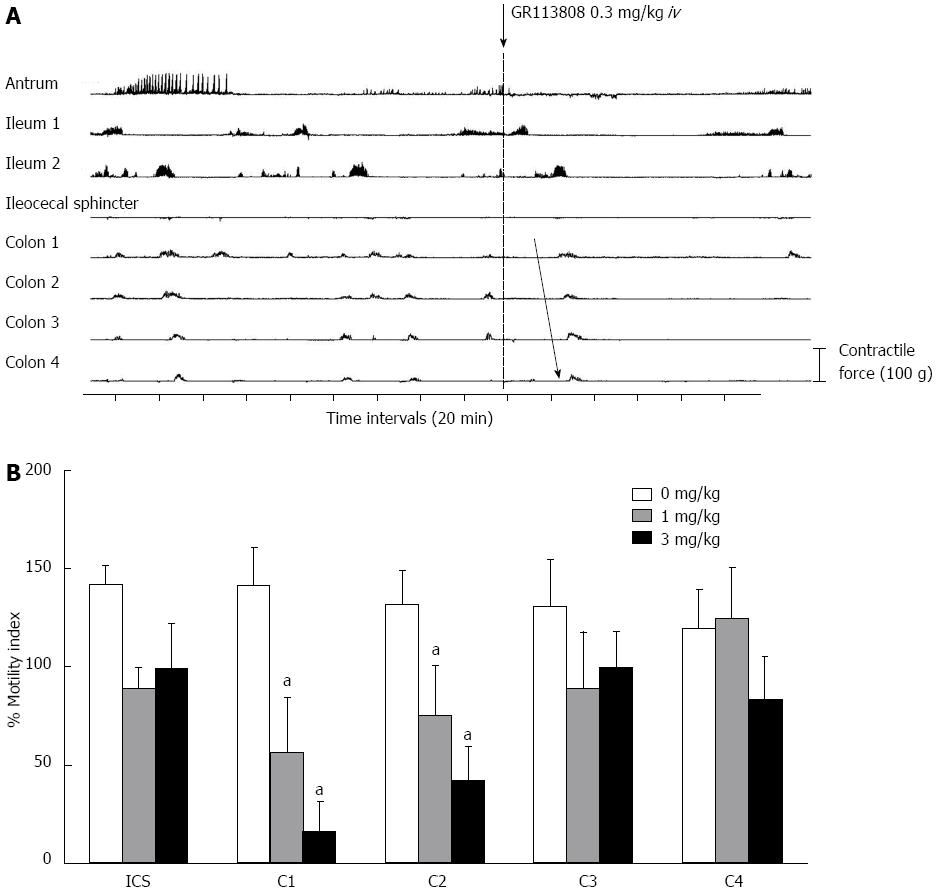INTRODUCTION
Over 95% of the 5-hydroxytryptamine (5-HT) in the body is found in the gastrointestinal tract; 90% of the gastrointestinal 5-HT is contained within enterochromaffin cells[1,2], and the remaining 10% is contained within the enteric neurons[3,4]. Seven major types and multiple subtypes of 5-HT receptors have been identified. 5-HT receptors that are known to affect gut motor functions are those belonging to the 5-HT1, 2, 3, 4 and 7 subtypes[5]. 5-HT has a variety of actions; it can cause smooth-muscle contraction (via cholinergic nerve stimulation) or relaxation (via stimulation of inhibitory nitric oxide-releasing neurons)[6]. Mucosal release of 5-HT stimulates both intrinsic sensory neurons (most likely via 5-HT4 receptors) and extrinsic sensory neurons (via 5-HT3 receptors); these actions modulate sensation[7]. Previous studies have shown that 5-HT3 and 5-HT4 receptor agonists stimulate gastrointestinal motility[8-12]. However, the effects of these antagonists are unknown.
Irritable bowel syndrome (IBS) is a common gastrointestinal disorder associated with altered motility, secretion and visceral sensation[5]. Stress is known to strongly contribute to the pathogenesis of IBS[13]. Data have shown that systemic administration of 5-HT3 receptor antagonists abolishes the abnormal contractions and visceral sensations induced by stress[14-16], leading to the use of 5-HT3 receptor antagonists in the treatment of diarrhea-predominant IBS. However, the effects of 5-HT3 receptor antagonists on normal colonic motor activity are controversial. Previous studies have shown that 5-HT3 antagonists have no effect on colonic motor activity during the interdigestive state in dogs and humans[17-19]. By contrast, the migrating motor complex in the murine small and large bowel is abolished by 5-HT3 antagonist activity[20]. Ondansetron, a 5-HT3 receptor antagonist, has been shown to delay colonic transit time in healthy subjects[21-23] and tends to slow left-sided colonic transit in patients with diarrhea-predominant IBS[24]. The effect of 5-HT3 receptor antagonists on normal colonic motor activity is still unknown. However, these studies suggest that 5-HT3 receptor antagonists may have an inhibitory effect on colonic motor activity.
5-HT2B receptors are expressed by the smooth muscle of the adult human gut[25], but their functions are unclear. It is known that 5-HT2B receptor antagonists inhibit visceral hypersensitivity[26]. These data suggest that 5-HT2B receptor antagonists also have a potential therapeutic role in the treatment of IBS. The effects of 5-HT2B receptor antagonists on normal colonic motor activity in vivo remain unknown.
5-HT4 receptors are distributed along the gut, where they may play a role in mediating smooth muscle tone, peristaltic reflex and mucosal secretion. In healthy humans, 5-HT4 receptor agonists have been demonstrated to stimulate both whole gut transit and colonic transit. Clinically, 5-HT4 receptor agonists are used for patients suffering from gastro-esophageal reflux disease, dyspepsia or constipation-predominant IBS[5,27,28]. As with the 5-HT3 receptors, the effects of 5-HT4 receptors are complex. 5-HT4 receptors mediate both the relaxation and contraction of circular smooth muscle[28-31]. The effect of 5-HT4 receptor antagonists on normal colonic motor activity remains unknown.
This study aimed to determine the effects of 5-HT2B, 5-HT3 and 5-HT4 receptor antagonists on normal colonic motor activity in conscious dogs.
MATERIALS AND METHODS
Preparation of animals
Experiments were completed in 5 healthy conscious dogs of both sexes, each weighing 8-11 kg. The procedures were approved by the Review Committee on Animal Use of Gunma University, Maebashi, Japan. Overnight-fasted dogs were anesthetized by a single intravenous injection of thiopental sodium (Ravonal; Tanabe Pharmaceutical, Osaka, Japan) at a dose of 20 mg/kg. General anesthesia was maintained by endotracheal inhalation of halothane (Fluothane; Takeda Chemical Industries, Osaka, Japan) and oxygen. A Silastic tube (Silastic 602-205; Dow Corning, Midland, MI) was inserted into the superior vena cava through a branch of the right internal jugular vein (jugular tube). The abdominal cavity was opened, and eight force transducers[32] were implanted on the serosal surfaces of the gastric antrum, terminal ileum (5 and 15 cm proximal to ileocecal sphincter) (I1/I2), ileocecal sphincter (ICS) and colon (C1-C4); C1 was placed 5 cm distal to the ICS, and C4 was placed 5 cm proximal to the peritoneal reflection. C2 and C3 were placed at equal distances between C1 and C4 (Figure 1). The ICS was identified by inspection and palpation. Wires from each force transducer were tunneled subcutaneously to the dorsum and connected to an eight-channel telemeter (GTS-800; Star Medical, Tokyo, Japan); gastrointestinal and colonic contractile activities were thereby continuously recorded on a computer (Adif1412.dill; Star Medical).
Figure 1 Scheme of the dog model and the locations of the force transducers implanted in the canine gastrointestinal tract.
Force transducers were implanted in the colon on the serosal surfaces of the gastric antrum (A), terminal ileum [5 and 15 cm proximal to ileocecal sphincter (ICS); I1-I2], ICS and colon (C1-C4); C1 was placed 5 cm distal to the ICS and C4 5 cm proximal to the peritoneal reflection. C2 and C3 were implanted equidistantly between C1 and C4.
After the operation, the dogs were housed in individual experimental cages. They were fasted for 2 d after this procedure and maintained by intravenous infusion of Lactec G (Otsuka Pharmaceutical, Tokyo, Japan) at a daily volume of 500 mL. Cefmetazole (1 g) was administered intravenously, once preoperatively and once on postoperative day 1. The dogs were allowed to recover for ≥ 10 d. They were fed normal dog food (20 g/kg; Funabashi Farm, Funabashi, Japan) once daily and provided water ad libitum.
After all experiments were completed, the dogs were sacrificed by an overdose of potassium chloride. Specimens of ICS were then fixed in 10% formalin and stained with hematoxylin and eosin. Proper placement of the transducers was confirmed.
Drugs
Ondansetron, a 5-HT3 receptor antagonist, was purchased from Sigma Japan (Tokyo). GR113808, a selective 5-HT4 receptor antagonist[33], was purchased from Wako Pure Chemical Co. (Osaka, Japan). RQ-00310941, a novel, potent, and selective 5-HT2B receptor antagonist[34], was synthesized by RaQualia Pharma Inc. (Aichi Japan). Ondansetron was dissolved in distilled water, GR113808 was dissolved in DMSO, and RQ-00310941 was dissolved in acid DMSO.
Experimental protocol and recording of contractile activity
The dogs were fasted overnight before each experiment. After the interdigestive motor complex[35] had been recorded at the antrum, ≥ 2-h of contractile activity was recorded. Test material or vehicle (5 mL of 154 mmol/L NaCl solution) alone was then administered as an intravenous bolus injection during a quiescent state of the whole colon in the interdigestive state. The experiments were performed with the following treatment doses: ondansetron (0.01, 0.03, 0.10 and 0.30 mg/kg), GR 113808 (0.1 and 0.3 mg/kg), and RQ-00310941 (1, 3 and 10 mg/kg). Contractile activities were recorded for ≥ 2-h after administration. All experiments were carried out in a random order, and the test material was given once per day.
Data analysis
The recorded mechanical activities were analyzed using software for analysis of gastrointestinal motility (8STAR, Star Medical Co., Ltd). The analysis of colonic contractile activity (from ICS to C4) was performed for 1 h both before and after administration. The mean motility index (MI) and average MI of colonic contractile activity were recorded at each site. The MI was defined as the integrated area between baseline (zero level) and the contractile wave expressed in motor units. This parameter was expressed as the inhibition ratio: the ratio of contractile activity before and after drug administration.
Statistical analysis
Student’s t test was used for statistical analysis. The results are expressed as the mean ± SD. P < 0.05 was considered statistically significant.
RESULTS
Effects of 5-HT2B, 5-HT3 and 5-HT4 receptor antagonists on gastric and terminal ileum motility
5-HT2B, 5-HT3 and 5-HT4 receptor antagonists had no contractile effect on the fasted canine terminal ileum (I1, I2) during the observation period (Figures 2, 3, 4 and 5). In contrast, the 5-HT3 and 5-HT4 receptor antagonists both significantly inhibited phase III of the interdigestive motor complex of the antrum (Figures 4 and 5).
Figure 2 Inhibition ratio based on comparing the drug effects to before 5-hydroxytryptamine receptor antagonist administration in the terminal ileum (I1-I2).
A systematic change was not observed. Values are mean ± SE. 5-HT: 5-hydroxytryptamine; I1:Ileum; I2: Terminal ileum.
Figure 3 5-hydroxytryptamine 2B receptor antagonists on normal colonic motor activity.
A: Typical effect of the 5-hydroxytryptamine (5-HT) 2B receptor antagonist. The 5-HT2B receptor antagonist had no contractile effect on the whole intestine; B: The inhibition ratio compared with before 5-HT2B receptor antagonist administration. A systematic change was not observed. Values are mean ± SE. ICS: Ileocecal sphincter; C1-4: Colon 1-4.
Figure 4 5-hydroxytryptamine 3 receptor antagonists on normal colonic motor activity.
A: Typical effect of the 5-hydroxytryptamine (5-HT) 3 receptor antagonist. The 5-HT3 receptor antagonist inhibited phase III of the interdigestive motor complex at the antrum and whole colonic motor activity; B: The inhibition ratio compared with before 5-HT3 receptor antagonist administration. The inhibitory effect of the 5-HT3 receptor antagonist was dose dependent in the proximal colon (ICS-C2). At a dose of 0.3 mg/kg, whole colonic motor activity was inhibited significantly. Values are mean ± SE. aP < 0.05 vs control (0 mg/kg). ICS: Ileocecal sphincter; C1-4: Colon 1-4.
Figure 5 5-hydroxytryptamine 4 receptor antagonists on normal colonic motor activity.
A: Typical effect of the 5-hydroxytryptamine (5-HT) 4 receptor antagonist. The 5-HT4 receptor antagonist inhibited phase III of the interdigestive motor complex at the antrum and whole colonic motor activity, CMMCs corresponding to phase III of the migrating motor complex at the ileum were sometimes observed (see arrow); B: The inhibition ratio compared with before 5-HT4 receptor antagonist administration. The inhibitory effect of the 5-HT4 receptor antagonist was dose dependent in the proximal colon (C1-C2). Values are mean ± SE. aP < 0.05 vs control (0 mg/kg). ICS: Ileocecal sphincter; C1-4: Colon 1-4.
Effects of 5-HT2B, 5-HT3 and 5-HT4 receptor antagonists on normal colonic motor activity
The 5-HT2B receptor antagonist had no contractile effect on normal colonic motor activity (Figure 3). However, both the 5-HT3 and 5-HT4 receptor antagonists inhibited colonic motor activity (Figures 4 and 5). At 0.3 mg/kg, the 5-HT3 receptor antagonist significantly inhibited whole colonic motor activity (ICS - C4) (72% ± 9% vs -11% ± 6%, 70% ± 10% vs 6% ± 10%, 65% ± 15% vs 1% ± 11%, 61% ± 7% vs 5% ± 9% and 68% ± 7% vs -10% ± 3%, respectively; Figure 4). In the proximal colon, the inhibitory effects of the 5-HT3 and 5-HT4 receptor antagonists were dose dependent. However, no dose-dependent response was observed in the distal colon. Upon administration of the 5-HT4 receptor antagonist, colonic migrating motor complexes (CMMCs) corresponding to phase III of the migrating motor complex at the ileum were sometimes observed (Figure 5, see arrow). The motor complex independent of phase III of the migrating motor complex tended to be inhibited (Figure 5). These inhibited effects were observed for at least 1 h.
DISCUSSION
Previous studies have investigated the effects of 5-HT receptor antagonists on abnormal colonic motor activity, following either the administration of 5-HT or the induction of stress[14,26,31,36,37]. This study is the first to investigate the effects of 5-HT receptor antagonists on normal colonic motor activity in dogs using a force transducer.
In this study, 5-HT3 and 5-HT4 receptor antagonists inhibited normal colonic motor activity. In contrast, a 5-HT2B receptor antagonist had no contractile effect on normal colonic motor activity. The 5-HT3 receptor antagonist inhibited phase III of the interdigestive motor complex of the antrum. None of the three 5-HT receptor antagonists had contractile effects on the fasted dog terminal ileum.
The effects of 5-HT3 receptor antagonists on colonic motor activity are controversial. In the present study, the 5-HT3 receptor antagonist inhibited normal colonic motor activity. However, Yoshida et al[17] reported that ondansetron (GR38032F) had no contractile effect on normal colonic motor activity in the interdigestive state in dogs. In their study, the 5-HT3 receptor antagonist was administered at a high dose of 1 mg/kg. It is possible that a higher dose of the 5-HT3 receptor antagonist may paradoxically have no contractile effect on normal colonic motor activity.
Because we administered the 5-HT3 receptor antagonist systemically, we were unable to determine its mechanism of action. We did observe, however, that the inhibitory effects were exerted in the extrinsic denervation region[38] (data not shown), suggesting that it acted locally.
How colonic contractions are generated is unclear. It is known that the pacemaker of colonic contractions lies within the colon wall itself because contractions can occur in an isolated colon. The pacemaker itself, however, has not been characterized. Heredia et al[39] showed that the initiation of colonic contractions requires serotonin. Dickson et al[40] demonstrated that 5-HT initially excites 5-HT3 receptors on the mucosal endings of Dogiel type II/AH neurons and that this is coincidental with colonic contractions. It is possible that the inhibitory effects of 5-HT3 receptor antagonists demonstrated in this study may act at this site. Bharucha et al[41] showed that a 5-HT4 receptor antagonist (SB-207266) tended to delay colonic transit. Consistent with this, in our study, the 5-HT4 receptor antagonist inhibited colonic motor activity. Studies have shown that receptors on contractile nerves may be more sensitive to receptor antagonism than those on relaxation nerves[22-25]. We hypothesize that the 5-HT4 receptor antagonist inhibitory effect on colonic contractile nerves may be a mechanism that results in the delay of colonic transit.
Glucagon and scopolamine butylbromide are commonly used as antispasmodic premedications for colonoscopy. In addition, 5-HT3 and 5-HT4 receptor antagonists may also be used as premedications for colonoscopy. In this study, we used ondansetron as the 5-HT3 receptor antagonist. Ondansetron has no effect on visceral sensations[28]. Visceral hypersensitivity has been proposed as a mechanism of IBS, and Kim et al[42] have reported that the degree of pain perception during colonoscopy is higher in IBS patients than in non-IBS patients. Alosetron, which can abolish visceral sensations[14], may be used as a premedication for colonoscopy without pain. However, whether alosetron is effective in controlling colonic motor activity has not been conclusively determined.
In a study by Ohashi-Doi et al[26], a 5-HT2B receptor antagonist inhibited visceral hypersensitivity and reduced restraint stress-induced defecation It is therefore logical to hypothesize that a 5-HT2B receptor antagonist may have therapeutic potential for the treatment of non-constipation IBS. Bassil et al[43] have previously shown that high-dose (10 and 30 mg/kg) 5-HT2B antagonists inhibit colonic motility and defecation in normal mice. The present study did not confirm their findings, as the 5-HT2B receptor antagonist had no contractile effect on normal colonic motor activity. However, we only evaluated doses up to 3 mg/kg. By contrast, our previous study showed that RQ-00310941 at 3 mg/kg p.o. inhibited restraint stress-induced defecation in TNBS-treated rats[34]. In that preliminary study, rats were administered 3 mg/kg TNBS orally, but the plasma concentration of RQ-00310941 was greater than that in the dogs in the current study, which were also administered 3 mg/kg iv (data not shown). We therefore speculate that RQ-00310941 can inhibit restraint stress-induced defecation at higher doses.
In the proximal colon, the inhibitory effects of 5-HT3 and 5-HT4 antagonists were dose dependent. However, this inhibition was dose independent in the distal colon. Nagakura et al[36] also showed that the effect of a 5-HT4 receptor agonist on colonic motor activity in the proximal colon was stronger than that in the distal colon. A different distribution of 5-HT receptors in the distal colon compared with the proximal colon may explain this effect. These confounding effects may also be based on a differential sensitivity to drugs in the proximal and distal colon[44,45]. Further studies are needed to clarify this result. In conclusion, 5-HT3 and 5-HT4 receptor antagonists inhibited phase III of the interdigestive motor complex at the antrum and colonic motor activity. The 5-HT2B receptor antagonist had no contractile effect on normal colonic motor activity.
COMMENTS
Background
Most of the body’s 5-hydroxytryptamine (5-HT) is found in the intestinal tract, where it helps regulate intestinal motor activity. The 5-HT receptors that are known to affect gut motor functions are those belonging to the 5-HT1, 2, 3, 4 and 7 subtypes.
Research frontiers
Irritable bowel syndrome (IBS) is a common gastrointestinal disorder associated with altered motility, secretion and visceral sensation. Recently, 5-HT was identified as the cause of IBS.
Innovations and breakthroughs
Previous studies have investigated the effects of 5-HT receptor antagonists on abnormal colonic motor activity, following either the administration of 5-HT or the induction of stress. This study is the first to investigate the effects of 5-HT receptor antagonists on normal colonic motor activity in dogs.
Applications
The study results suggest that 5-HT3 and 5-HT4 receptor antagonists may also be used as premedications for colonoscopy. 5-HT2B receptor antagonists may be used for the treatment of diarrhea-predominant IBS without the side effect of constipation.
Terminology
Motility index (MI): MI was defined as the integrated area between baseline (zero level) and the contractile wave expressed in motor units. MI is an index used when analyzing gastrointestinal motility. 5-HT: Over 95% of the 5-HT in the body is found in the gastrointestinal tract; 90% of the gastrointestinal 5-HT is found within enterochromaffin cells. 5-HT receptors are known to affect gut motor functions.
Peer review
This is a good descriptive study in which the authors analyze the effects of 5-HT3, 5-HT4 and 5-HT2B receptor antagonists on normal gastrointestinal motility. 5-HT3 and 5-HT4 receptor antagonists inhibited colonic motor activity. The 5-HT2B receptor antagonist had no contractile effect on normal colonic motor activity.













